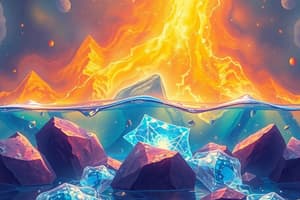Podcast
Questions and Answers
What is the main function of electrolytes in the body?
What is the main function of electrolytes in the body?
- To regulate fluid balance and provide minerals for essential functions (correct)
- To transport oxygen and carbon dioxide throughout the body
- To produce hormones and enzymes
- To provide energy for cellular processes
Which of the following is NOT a function of electrolytes in the body?
Which of the following is NOT a function of electrolytes in the body?
- Contracting muscles
- Producing blood cells in the bone marrow (correct)
- Maintaining osmotic pressure
- Regulating nerve impulse transmission
Why are electrolytes considered to have greater osmotic power than nonelectrolytes?
Why are electrolytes considered to have greater osmotic power than nonelectrolytes?
- They are larger molecules and therefore exert more pressure on cell membranes
- They are directly involved in the transport of water across cell membranes
- They dissociate into ions in water, increasing the number of particles and osmotic pressure (correct)
- They are more easily absorbed into the bloodstream than nonelectrolytes
What is the primary reason why electrolyte balance is typically referred to as salt balance?
What is the primary reason why electrolyte balance is typically referred to as salt balance?
Which of the following is NOT an example of an electrolyte?
Which of the following is NOT an example of an electrolyte?
What is the primary cause of dehydration?
What is the primary cause of dehydration?
Which of the following is NOT a symptom of hypovolemia?
Which of the following is NOT a symptom of hypovolemia?
Which of these is a cause of hypervolemia?
Which of these is a cause of hypervolemia?
Which of the following is a primary clinical sign of dehydration?
Which of the following is a primary clinical sign of dehydration?
Which of the following is NOT a characteristic symptom of fluid excess?
Which of the following is NOT a characteristic symptom of fluid excess?
What is the primary characteristic of hypotonic hydration?
What is the primary characteristic of hypotonic hydration?
Which of the following disorders of water balance involves a reduction in fluid intake?
Which of the following disorders of water balance involves a reduction in fluid intake?
Which of the following best describes the primary function of potassium-sparing diuretics?
Which of the following best describes the primary function of potassium-sparing diuretics?
What percentage of body fluid is accounted for by plasma?
What percentage of body fluid is accounted for by plasma?
Which compartment experiences a net water flow when ECF osmolality increases?
Which compartment experiences a net water flow when ECF osmolality increases?
What triggers the release of ADH when plasma osmolality rises?
What triggers the release of ADH when plasma osmolality rises?
Which type of diuretic primarily targets the thick ascending loop of the nephron?
Which type of diuretic primarily targets the thick ascending loop of the nephron?
How is the movement of ions across cell membranes described?
How is the movement of ions across cell membranes described?
Which of the following fluids is considered transcellular fluid?
Which of the following fluids is considered transcellular fluid?
What is the osmolality range that body fluids are maintained at?
What is the osmolality range that body fluids are maintained at?
What is a general mechanism by which fluid excretion is promoted?
What is a general mechanism by which fluid excretion is promoted?
What condition occurs when there is more water retained than sodium?
What condition occurs when there is more water retained than sodium?
What is a potential severe result of water intoxication?
What is a potential severe result of water intoxication?
Which of the following is a cause of edema due to increased fluid out of blood?
Which of the following is a cause of edema due to increased fluid out of blood?
What condition results from a hypoproteinemic state?
What condition results from a hypoproteinemic state?
Which symptom is associated with edema in the brain?
Which symptom is associated with edema in the brain?
Which of the following conditions can directly cause increased capillary hydrostatic pressure?
Which of the following conditions can directly cause increased capillary hydrostatic pressure?
What describes a non-pitting edema?
What describes a non-pitting edema?
Which factor can lead to decreased fluid intake in the blood?
Which factor can lead to decreased fluid intake in the blood?
What serum sodium level indicates hyponatremia?
What serum sodium level indicates hyponatremia?
Which of the following is a symptom of hypernatremia?
Which of the following is a symptom of hypernatremia?
What is a common cause of hypokalemia?
What is a common cause of hypokalemia?
What serum potassium level indicates hyperkalemia?
What serum potassium level indicates hyperkalemia?
Which condition is likely associated with hypocalcemia?
Which condition is likely associated with hypocalcemia?
What is a typical manifestation of hypercalcemia?
What is a typical manifestation of hypercalcemia?
Hypochloremia is often associated with which condition?
Hypochloremia is often associated with which condition?
What is a common cause of hyperchloremia?
What is a common cause of hyperchloremia?
What level indicates hypomagnesemia?
What level indicates hypomagnesemia?
What is a noticeable symptom of hypermagnesemia?
What is a noticeable symptom of hypermagnesemia?
What is hypophosphatemia defined as?
What is hypophosphatemia defined as?
Which condition is often associated with hyperphosphatemia?
Which condition is often associated with hyperphosphatemia?
How much of the total body water is extracellular fluid (ECF)?
How much of the total body water is extracellular fluid (ECF)?
What percentage of total body water is intracellular fluid (ICF)?
What percentage of total body water is intracellular fluid (ICF)?
Flashcards
Body Fluids
Body Fluids
The liquids containing water and dissolved substances in the body.
Electrolytes
Electrolytes
Dissolved particles that dissociate into ions and conduct electricity in body fluids.
Nonelectrolytes
Nonelectrolytes
Substances that do not dissociate into ions in water and cannot conduct electricity.
Osmotic Power
Osmotic Power
Signup and view all the flashcards
Electrolyte Balance
Electrolyte Balance
Signup and view all the flashcards
Potassium sparing diuretics
Potassium sparing diuretics
Signup and view all the flashcards
Fluid imbalance
Fluid imbalance
Signup and view all the flashcards
Hypovolemia
Hypovolemia
Signup and view all the flashcards
Dehydration
Dehydration
Signup and view all the flashcards
Fluid excess
Fluid excess
Signup and view all the flashcards
Hypervolemia
Hypervolemia
Signup and view all the flashcards
Oliguria
Oliguria
Signup and view all the flashcards
Pulmonary edema
Pulmonary edema
Signup and view all the flashcards
Plasma
Plasma
Signup and view all the flashcards
Interstitial Fluid (IF)
Interstitial Fluid (IF)
Signup and view all the flashcards
Transcellular Fluid
Transcellular Fluid
Signup and view all the flashcards
Osmotic Pressure
Osmotic Pressure
Signup and view all the flashcards
ADH
ADH
Signup and view all the flashcards
Diuretics
Diuretics
Signup and view all the flashcards
Loop Diuretics
Loop Diuretics
Signup and view all the flashcards
Water Intoxication
Water Intoxication
Signup and view all the flashcards
Hyponatremia
Hyponatremia
Signup and view all the flashcards
Fluid Deficiency
Fluid Deficiency
Signup and view all the flashcards
Edema
Edema
Signup and view all the flashcards
Increased Capillary Hydrostatic Pressure
Increased Capillary Hydrostatic Pressure
Signup and view all the flashcards
Colloid Osmotic Pressure
Colloid Osmotic Pressure
Signup and view all the flashcards
Clinical Manifestations of Edema
Clinical Manifestations of Edema
Signup and view all the flashcards
Hypocalcemia
Hypocalcemia
Signup and view all the flashcards
Hypercalcemia
Hypercalcemia
Signup and view all the flashcards
Hypochloremia
Hypochloremia
Signup and view all the flashcards
Hyperchloremia
Hyperchloremia
Signup and view all the flashcards
Hypomagnesemia
Hypomagnesemia
Signup and view all the flashcards
Hypermagnesemia
Hypermagnesemia
Signup and view all the flashcards
Hypophosphatemia
Hypophosphatemia
Signup and view all the flashcards
Hyperphosphatemia
Hyperphosphatemia
Signup and view all the flashcards
Intracellular Fluid (ICF)
Intracellular Fluid (ICF)
Signup and view all the flashcards
Extracellular Fluid (ECF)
Extracellular Fluid (ECF)
Signup and view all the flashcards
Total Body Water
Total Body Water
Signup and view all the flashcards
Study Notes
Fluid and Electrolyte Balance
- Electrolytes are salts, acids, bases, and some proteins
- Electrolyte balance often refers only to salt balance
- Salts control fluid movement, provide minerals for excitability, and are related to secretory activity and membrane permeability
- Salts enter the body through ingestion and metabolism
- Salts are lost through perspiration, feces, urine, and vomit
Composition of Body Fluids
- Water is the universal solvent in body fluids
- Solutes are classified as nonelectrolytes and electrolytes
- Body fluids contain electrolytes, which dissociate into ions in water
- Examples of electrolytes include inorganic salts, acids, bases, and some proteins
- Ions conduct electrical current
- Electrolytes have greater osmotic power than nonelectrolytes and cause fluid shifts
Altered Sodium Balance: Hyponatremia
- Serum sodium level < 135 mEq/L
- Causes include vomiting, diarrhea, and sweating
- Manifestations are related to plasma hypoosmolality and cellular swelling
- Symptoms include muscle twitching, weakness, hypotension, tachycardia, oliguria, anuria, and altered neuronal function (nausea, vomiting, lethargy)
Altered Sodium Balance: Hypernatremia
- Serum sodium > 145 mEq/L
- Causes include excessive dietary sodium intake and loss of body water
- Manifestations include intracellular dehydration (water movement from ICF to ECF), agitation, restlessness, decreased level of consciousness, hypertension, tachycardia, edema, and weight gain
Altered Potassium Balance: Hypokalemia
- Potassium level < 3.5 mEq/L
- Causes include reduced intake, increased loss due to diuretics, severe vomiting, and diarrhea
- Manifestations include membrane hyperpolarization (decreased neuromuscular excitability), cardiac arrhythmias, dizziness, hypotension, skeletal muscle weakness, and smooth muscle atony (nausea, anorexia, abdominal distension)
Altered Potassium Balance: Hyperkalemia
- Potassium level > 5 mEq/L
- Causes include iatrogenic (inappropriate drug use), shift of K+ from ICF to ECF, and decreased renal excretion
- Manifestations include membrane depolarization (increased neuromuscular excitability), cardiac arrest, abdominal cramping, and flaccid paralysis (reduced muscle tone)
Altered Calcium Balance: Hypocalcemia
- Calcium level < 4.5 mEq/L
- Causes include medications (heparin/glucagon), severe burns, kidney failure, thyroid disorder, vitamin D deficiency, and sepsis
- Manifestations include anxiety, increased excitability and muscle tetany, muscle twitch, spasm, cardiac arrhythmia, and hypotension
Altered Calcium Balance: Hypercalcemia
- Calcium level > 5.2 mEq/L
- Causes include excessive bone breakdown, thyroid disease, excessive calcium supplements intake, and excessive calcium-containing antacids
- Manifestations include decreased neuromuscular irritability (inhibits neurons and muscle cells), confusion, headaches, irritability, constipation, nausea, vomiting, heart arrhythmias, and muscle weakness
Altered Chlorine Balance: Hypochloremia
- Chlorine level < 98 mEq/L
- Often associated with hyponatremia, hypokalemia, and metabolic alkalosis
- Causes include vomiting, diarrhea, and diuretics
- Manifestations include excessive tone of muscle, tetany, weakness, twitching, shallow, depressed breathing, paralysis, and mental confusion
Altered Chlorine Balance: Hyperchloremia
- Chlorine level > 108 mEq/L
- Causes include severe dehydration, kidney failure, hemodialysis, and traumatic brain injury
- Manifestations include hyperchloremic metabolic acidosis, deep rapid breathing, headache, diminished cognitive ability, and cardiac arrest
Altered Magnesium Balance: Hypomagnesemia
- Magnesium level < 1.5mEq/L
- Associated with hypokalemia and hypocalcemia
- Causes include malnutrition, malabsorption, severe burns, alcoholism, and diuretic use
- Manifestations include tetany, muscle cramps, seizures, altered neuromuscular transmission, cardiac arrhythmia, and hypotension
Altered Magnesium Balance: Hypermagnesemia
- Magnesium level > 2.5mEq/L
- Less frequent than hypomagnesemia
- Causes include excessive intake of magnesium supplements, magnesium antacids, and end-stage renal disease
- Manifestations include reduced neuromuscular transmission and cell excitability, diminished reflexes, muscle weakness, and hypotension
Altered Phosphate Balance: Hypophosphatemia
- Phosphate level < 1.6 mEq/L
- Often associated with hypomagnesemia and hypokalemia
- Causes include severe burns, malnutrition, malabsorption, vitamin D deficiency, alcoholism, kidney disease, and prolonged diuretic use
- Manifestations include osteomalacia (soft bones), bone deformities, muscle weakness, tremor, and paresthesia (tingling, burning)
Altered Phosphate Balance: Hyperphosphatemia
- Phosphate level > 2.9 mEq/L
- Associated with hypocalcemia (reciprocal changes)
- Causes include fractures, bone disease, hypoparathyroidism, acromegaly, systemic infection, intestinal obstruction, and major tissue trauma
- Manifestations include no associated manifestations
Fluid Compartments
- Total body water is 60% of body weight (40 L in a 70 kg male)
- Two main compartments are intracellular fluid (ICF) and extracellular fluid (ECF)
- ICF comprises 40% of total body water, found inside cells
- ECF comprises 20% of total body water, outside cells and includes plasma (~5%), interstitial fluid (~14%), and transcellular fluid (~1%)
Fluid Movement Among Compartments
- Fluid exchange and mixing are continuous
- Movement is along osmotic gradients
- All body fluid osmolality is almost always equal
- Changes in solute concentration (any compartment) lead to net water flow
Fluid Regulation Cycle
- The cycle involves the hypothalamus, kidneys, and other organs
- ADH (antidiuretic hormone) is produced in response to changes in blood volume or osmolarity. ADH leads to water retention or excretion as needed
- In response to changes in blood pressure, the kidneys produce renin, regulating blood pressure and water balance. Hormones such as aldosterone, promote sodium retention or excretion
Diuretics
- Drugs that increase urine production to adjust fluid balance
- Types of diuretics include loop diuretics, thiazide diuretics, and potassium-sparing diuretics
- Each type targets a different segment of the nephron to promote fluid excretion
Disorders of Water Balance
- Categorized as total volume, concentration, or fluid distribution imbalances
- Disorders include fluid deficiency (negative balance), fluid excess (positive balance), and fluid sequestration (edema formation)
Hypovolemia (Fluid Deficiency)
- Deficit of body fluid volume
- Causes include excessive body fluid loss, reduction in fluid intake, loss of fluid due to a third space, or hemorrhage
- Manifestations include thirst, dry mucous membranes, weight loss, flattened neck veins, diminished skin turgor, prolonged capillary refill, decreased urine output, increased heart rate, decreased blood pressure, and altered level of consciousness
Dehydration (Fluid Deficiency)
- Negative fluid balance; body eliminates significantly more water than sodium
- ECF osmolality rises due to water loss through profuse sweating, water deprivation, diuretic abuse, endocrine disturbances (diabetes mellitus, ADH hyposecretion), or diabetes insipidus
- Dehydration affects all water compartments
- Clinical signs include skin turgor loss, sticky oral mucosa, thirst, dry flushed skin, and low urine output
Hypervolemia (Fluid Excess)
- Expansion of extracellular fluid, involving interstitial or vascular space
- Causes include heart failure, cirrhosis, kidney failure, excessive fluid replacement, and administration of osmotically active fluids
- Manifestations include increased blood pressure, increased sodium and water excretion, heart failure, and pulmonary edema
Hypotonic Hydration (Fluid Excess)
- Cellular overhydration (water intoxication)
- More water than sodium is retained or rapid, excess water ingestion
- Occurs after periods of strenuous activity, or excessive water intake without electrolyte replenishment which leads to a decrease in ECF osmolality and net osmosis of water into tissue cells
- Manifestations include swelling of the cells, severe metabolic disturbances (nausea, vomiting, muscular cramping, cerebral edema), possible death
Fluid Sequestration (Edema)
- Atypical accumulation of fluid in interstitial space
- Causes include increased fluid out of blood, decreased fluid into blood, (increased capillary hydrostatic pressure, decreased capillary oncotic pressure, increased capillary permeability, and lymphatic obstruction)
- Edema can result in impaired function in joints, organs like brain and lungs, and extremities like arms and legs
Studying That Suits You
Use AI to generate personalized quizzes and flashcards to suit your learning preferences.




